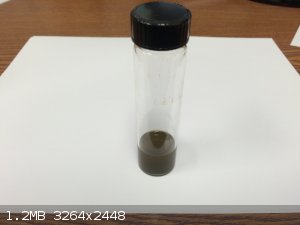| Pages:
1
..
3
4
5 |
Pumukli
National Hazard
   
Posts: 686
Registered: 2-3-2014
Location: EU
Member Is Offline
Mood: No Mood
|
|
On the basis of this sentence:
"For many purposes it is unnecessary to distill the reagent and the dark solution obtained on dissolution of the aluminium can be used directly."
This was copied from the remarks of the isopropoxide synth. procedure I found in the Hilgetag book.
As I wrote I never tried this reaction (except once decades ago but not remembering practically anything meaningful about that synthesis) but I
assumed the original authors wrote that sentence because they saw it was dark.
|
|
|
byko3y
National Hazard
   
Posts: 721
Registered: 16-3-2015
Member Is Offline
Mood: dooM
|
|
Ok, so after standing for 2-3 days, the mixture of aluminium turnings + iodine + isopropanol + some more stuff I've tried to use as a catalyst turned
less orange-red, almost colorless, so I tried distilling it. I recovered almost quantitively the isopropanol I've charged into the reaction, and
detected almost no reacted aluminium. Can't say precisely, but it's very small amount, close to my measurement error.
Most likely some really strong agitation and long reaction time is needed to get all the aluminium reacted, because clearly the iodine by itself is
not able to destroy the protective aluminium oxide layer at low temperature, and strong agitation destroys the layer mechanically. But in this case do
I need the iodine at all? If it all depends on mechanical force, why do I need anything else?
Few more researchers that failed with iodine in isopropanol:
http://images.library.wisc.edu/WI/EFacs/transactions/WT1896/...
and
http://archive.org/stream/philtrans07558607/07558607_djvu.tx...
I'd like to quote the aluminium alcoholates that were successfully prepared by the last researchers: ethylic, propylic, iso-butylic, amylic, benzylic,
phenylic, cresylic, and thymolic.
No methanol, no isopropanol, sorry.
[Edited on 22-5-2015 by byko3y]
|
|
|
blogfast25
International Hazard
    
Posts: 10562
Registered: 3-2-2008
Location: Neverland
Member Is Offline
Mood: No Mood
|
|
Quote: Originally posted by byko3y  | But in this case do I need the iodine at all? If it all depends on mechanical force, why do I need anything else?
|
Cos G-men are f*cking up your speriments?
|
|
|
WGTR
National Hazard
   
Posts: 971
Registered: 29-9-2013
Location: Online
Member Is Offline
Mood: Outline
|
|
Quote: Originally posted by byko3y  | Ok, so after standing for 2-3 days, the mixture of aluminium turnings + iodine + isopropanol + some more stuff I've tried to use as a catalyst turned
less orange-red, almost colorless, so I tried distilling it. I recovered almost quantitively the isopropanol I've charged into the reaction, and
detected almost no reacted aluminium. Can't say precisely, but it's very small amount, close to my measurement error.
Most likely some really strong agitation and long reaction time is needed to get all the aluminium reacted, because clearly the iodine by itself is
not able to destroy the protective aluminium oxide layer at low temperature, and strong agitation destroys the layer mechanically. But in this case do
I need the iodine at all? If it all depends on mechanical force, why do I need anything else? |
What I wonder, is where your iodine is going. Are you able to recover it? The solution I have is still sitting quietly on the table, either muddy
brown, purple, or green, depending on how one looks at it. Is it possible that your iodine is subliming away during the reaction? I don't understand
how your solution is going colorless otherwise under those conditions.
|
|
|
byko3y
National Hazard
   
Posts: 721
Registered: 16-3-2015
Member Is Offline
Mood: dooM
|
|
Probably the whole iodine reacted with aluminium and turned into AlI3, which is not capable of peneterating Al2O3 layer at this conditions (80°C,
IPA). Actually, I needed to add some copper salt to force the solution color to change, because without it even after 3 hours of heating and mild
agitation I could not see any changes. There was a slight turbidity in the solution, but it was mostly clear.
The slight yellow color of the solution most likely comes from some high boiling yellow compound, which I was able to distill from the mixture (0.5 ml
out of 35 ml IPA charged). AFAIK, if this was isopropoxide, it would hydrolyze rapidly, but I see no Al(OH)3, only a clear yellow oil.
After distillation of any volative products, I quickly washed the aluminium turnings with hydrochloric acid to remove water soluluble solids. The
resulting solution after some heating turned yellow, however I don't know why.
And by the way, when I charged a 13% solution of HCl into non-reacted aluminium turnings (so it would be easier to remove them through a narrow flash
neck), noticable reaction(bubbling) started even at room temperature, and after reaching something like 50-60°C the reaction became really vigorous.
So I'd say my aluminium has good reaction ability, but the IPA-I2 conditions led to an extreemly sluggish reaction.
|
|
|
WGTR
National Hazard
   
Posts: 971
Registered: 29-9-2013
Location: Online
Member Is Offline
Mood: Outline
|
|
I should mention that every day or two I go by and release pressure from the vial. Cracking the seal evidences a slight "hiss" as pressure is
released. I'm not even bothering to heat the material, it's just sitting quietly at room temperature. It's definitely a slow reaction at these
temperatures.
When I first pick up the vial after letting it sit for a day or so, I notice that there are considerable amounts of gray powder mixed in with the
remaining shiny aluminum powder. I'm going to let this reaction sit quietly in the corner. I plan to check on it periodically.

|
|
|
Nicodem
|
Thread Split
25-5-2015 at 07:06 |
| Pages:
1
..
3
4
5 |
|